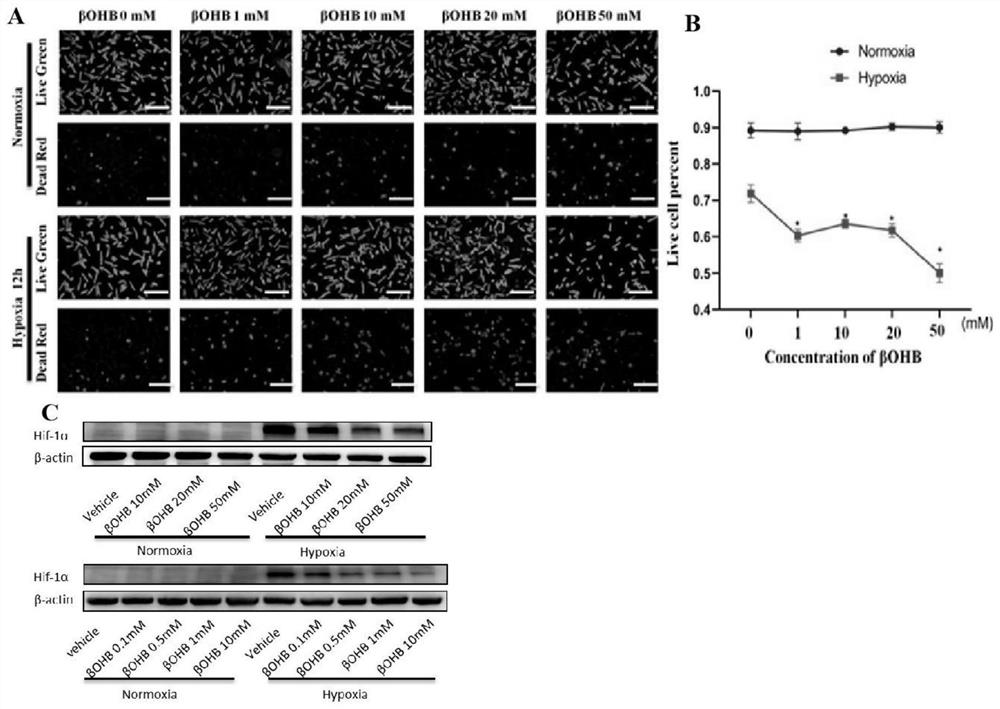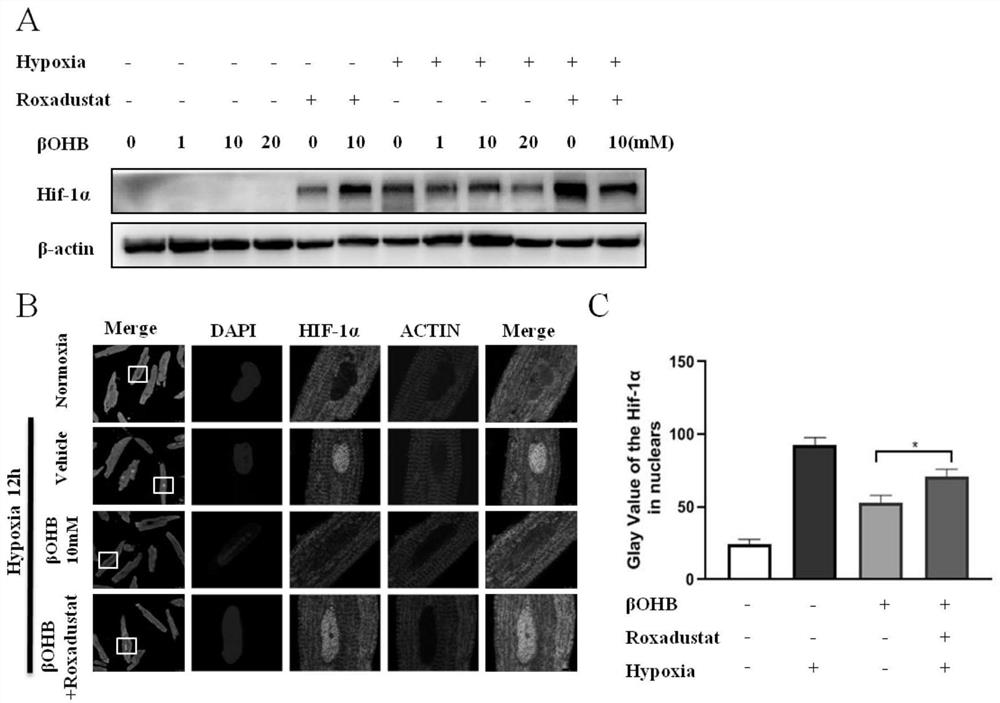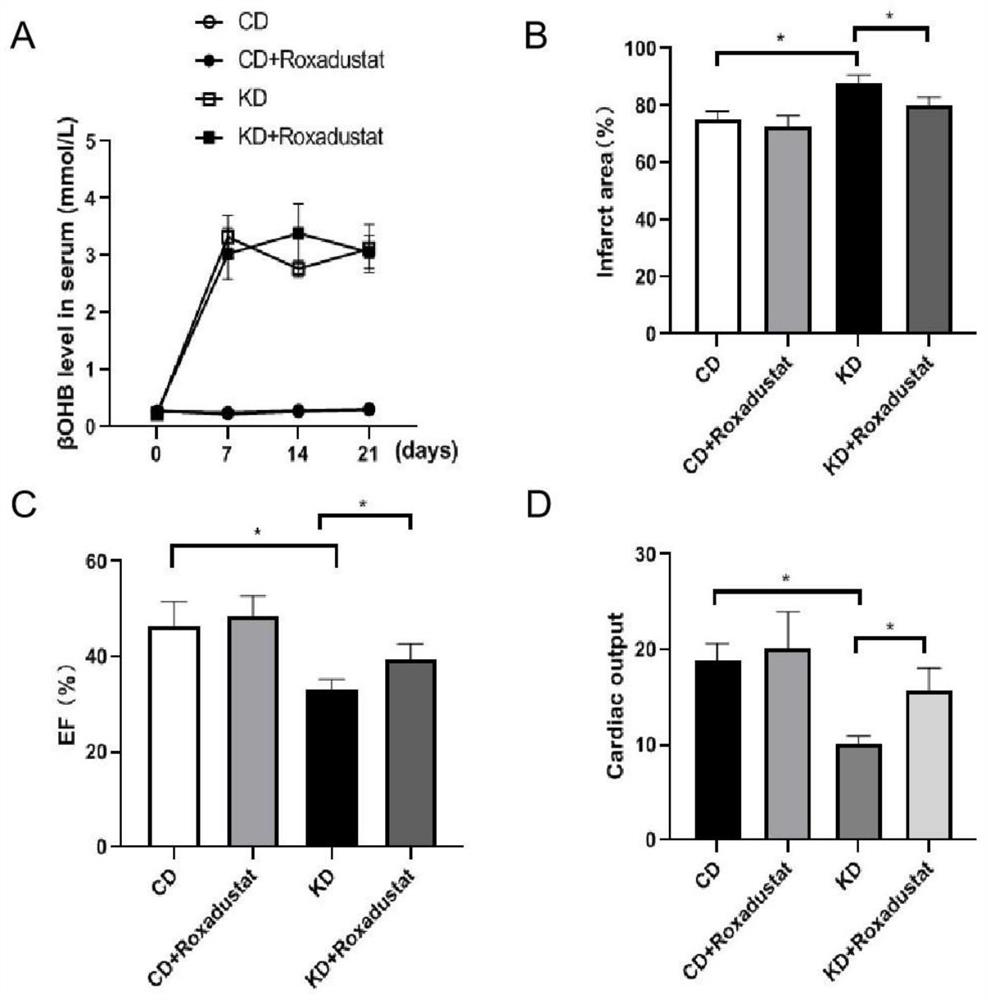Application of HIF-1 alpha degradation inhibitor in preparation of drug for coronary heart disease with increased ketone body level
A degradation inhibitor, HIF-1 technology, applied in the field of medicine, can solve the problems of unclear pathways of metabolic changes and few studies on ischemia
- Summary
- Abstract
- Description
- Claims
- Application Information
AI Technical Summary
Problems solved by technology
Method used
Image
Examples
Embodiment 1
[0028] Example 1: Elevating β-hydroxybutyric acid levels leads to increased cell death in hypoxic cardiomyocytes.
[0029] Such as figure 1 As shown, it is clear that β-hydroxybutyric acid aggravates hypoxic injury of cardiomyocytes by inhibiting HIF-1α, among which, figure 1 A. figure 1 B shows: the Live / Death junction shows that primary rat cardiomyocytes, after being given β-hydroxybutyric acid under hypoxic conditions, lead to cell death in a dose-dependent manner; figure 1 C shows: Western results show that after administration of β-hydroxybutyric acid, the expression of HIF-1α in hypoxic cardiomyocytes is down-regulated in a dose-dependent manner.
Embodiment 2
[0030] Example 2: Taking HIF-1α as the intervention target can alleviate hypoxic cardiomyocyte injury caused by high β-hydroxybutyric acid.
[0031] Such as figure 2 As shown, using the primary adult mouse cardiomyocytes and human ventricular myocytes, after hypoxic stimulation and β-hydroxybutyric acid, the HIF-1α degradation inhibitor roxadustat was used to up-regulate the expression of HIF-1α, which can Partially reversed β-hydroxybutyric acid-induced cardiomyocyte injury under hypoxic conditions; specifically, figure 2 A and 2B show that the results of Western Blot and immunofluorescence show that after hypoxia stimulation and β-hydroxybutyrate, the application of roxadustat can inhibit the degradation of HIF-1α, and then partially reverse the effect of β-hydroxybutyrate on HIF-1α. inhibitory effect; figure 2 C is the statistical analysis diagram of immunofluorescence results, which can also reflect the experimental results.
Embodiment 3
[0032] Example 3: Elevated levels of ketone bodies in the systemic circulation aggravated myocardial injury in mice with myocardial infarction, and roxadustat partially reversed this effect.
[0033] Animal level experiments: 60 male C57BL / 6 mice aged 6-8 weeks were used, 30 were given a normal diet, and 30 were given a ketogenic diet to establish a hyperketone mouse model. The animal model of myocardial infarction was established by ligation of the descending artery. One week after myocardial infarction, echocardiography was performed, and heart samples were collected for TTC, HE, and Masson staining to identify the myocardial infarction from pathology and morphology. Such as image 3As shown, the expression of HIF-1α was detected by Western-Blot and RT-PCR experiments, and it was found that compared with mice given a normal diet, increasing the level of ketone bodies in the blood can increase the size of myocardial infarction in mice and aggravate myocardial damage. Among th...
PUM
 Login to View More
Login to View More Abstract
Description
Claims
Application Information
 Login to View More
Login to View More - Generate Ideas
- Intellectual Property
- Life Sciences
- Materials
- Tech Scout
- Unparalleled Data Quality
- Higher Quality Content
- 60% Fewer Hallucinations
Browse by: Latest US Patents, China's latest patents, Technical Efficacy Thesaurus, Application Domain, Technology Topic, Popular Technical Reports.
© 2025 PatSnap. All rights reserved.Legal|Privacy policy|Modern Slavery Act Transparency Statement|Sitemap|About US| Contact US: help@patsnap.com



